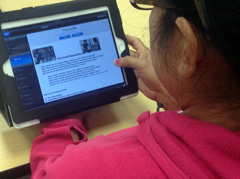The Pulse Archives
New way of learning on campus
By Steven Rodriguez | Pulse staff reporter

Isabel Rosales using canvas on her iPad.
Palo Alto College students are experiencing a change in online learning this fall. The school has adopted Canvas, a new online learning system that took the place of Blackboard.
At this time, 70 faculty members teach their courses in Canvas. This includes full-time and adjunct faculty.
Alyssa De La O, a sophomore Communications major, said, “It’s easier to access and is more efficient for the students. It’s a change that should have been made along time ago.”
The change from Blackboard to Canvas may seem like it’s going to be hard to get accustomed to, but Canvas almost feels like Facebook. It has profiles for students and instructors. You may upload your profile picture and access everyone’s contact information.
For students who have never used Canvas, a student guide is available at the top under the resources tab will help students.
“I would recommend that students using Canvas read the student guide to get a feel for what’s new to them,” said Tracey DeLillo, instructional designer at Palo Alto College.
To get access into Canvas, you go through ACES and go to your courses and click on your class that is using the program. Make sure you have your pop-up blocker off. If you don’t have it off, Canvas will not open.
Michelle Martinez, a freshman English major, said, “This is my first semester here at Palo Alto. In two of my classes, I use both Blackboard and Canvas, and I think that Canvas is very easy to use and good for first-time students.”
Another feature available in Canvas is Skype integration. You have to enter your Skype information, and if other students in your class have Skype, you may help each other with classwork from the comfort of your own home. Also social media sites, like Twitter and LinkedIn, allow you to connect with other students through Canvas.
Course notifications are also available. You may have them sent to your personal e-mail, so that you receive notifications for new assignments, discussions and grades. It’s very useful when you’re away from having access to Canvas, but you know to check it later.
“So many of my students are using their phones or their tablets,” said Diana Nystedt, an instructor of English at Palo Alto College. She was one of the first instructors to switch to Canvas, and has been very pleased with the switch.
The user interface of Canvas is very simple. It was designed for students by people who were students.
In addition, students and teachers are now able to upload videos for the class to see. Teachers can record lectures and post them. If students miss a day, they can go back and see what they missed.
Canvas has a free app in the app store for those who are always on the run or don’t have a computer, only a phone or a tablet. Right now, the Canvas app is only available on the iPod, iPad and iPhone, but an Android version is in the making and is set to come out by the end of 2012. This app has everything that you see when you use it on a computer, and you will be able to submit work.
Teachers also have a voice in how Canvas works. They can reach out to the Canvas production team for what they would like to see as a feature in Canvas.
This fall is the last semester that Palo Alto instructors and students will be using Blackboard. Canvas will take its place in Spring 2013 as the sole online learning system.
For more information on Canvas, go to:
https://alamo.instructure.com/courses/293886
October 2012
- New president wants a more engaged campus
- Elections 2012: To vote or not to vote
- PAC making it RREAL in classes
- New way of learning on campus
- Art, dance and music fill the fall semester
- STEM Center opens to support student success
- Ozuna renovation to be completed by June 1
- Campus offers convenient ways to get healthy
- Refreshed Strategic Plan: roadmap to future success
- Palo Alto College offers learning outside the classroom
- Technology in the classroom: winner or loser?
- Financial aid award changes affect students
- Finish up and make a difference
- Tutoring labs on campus provide much-needed help